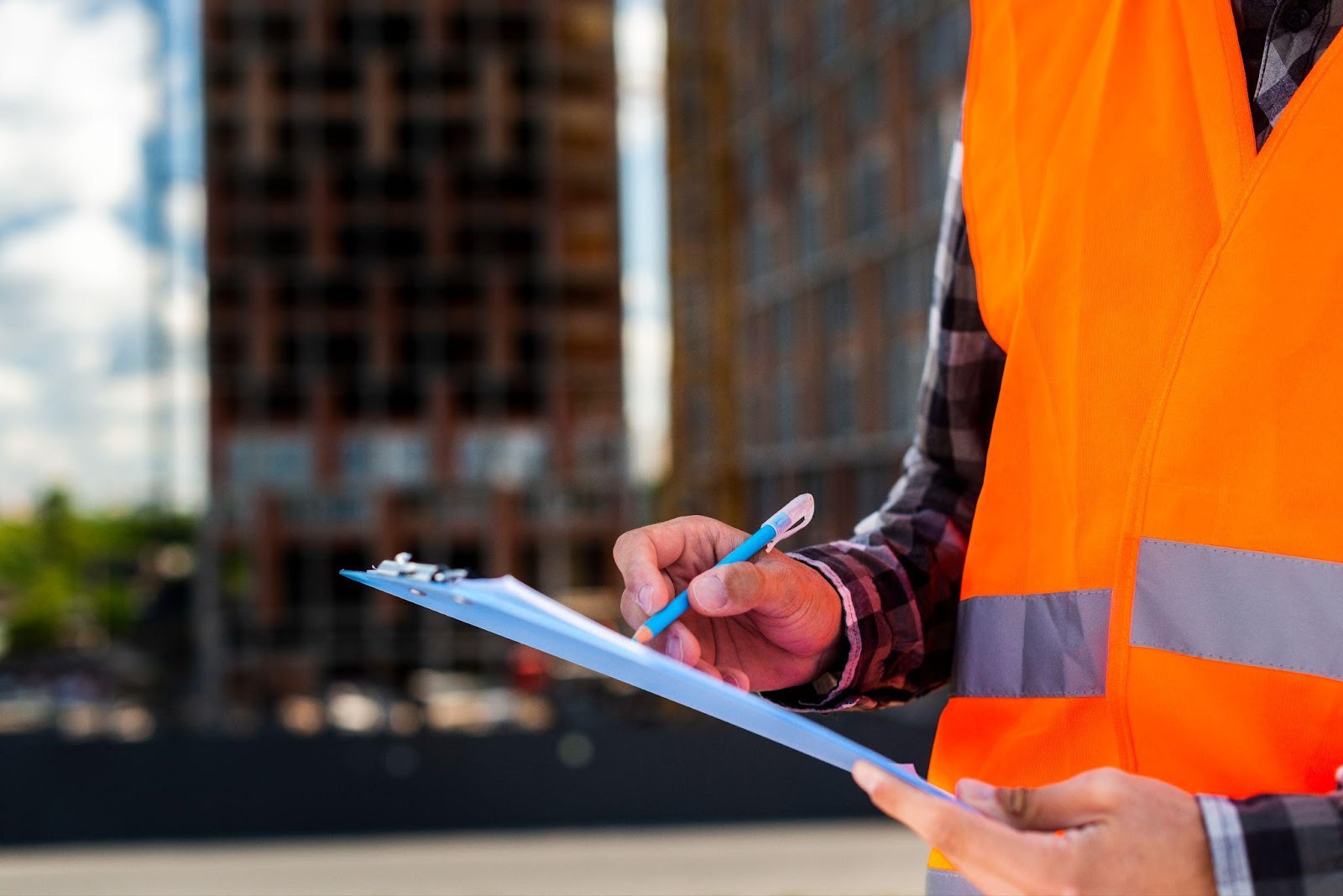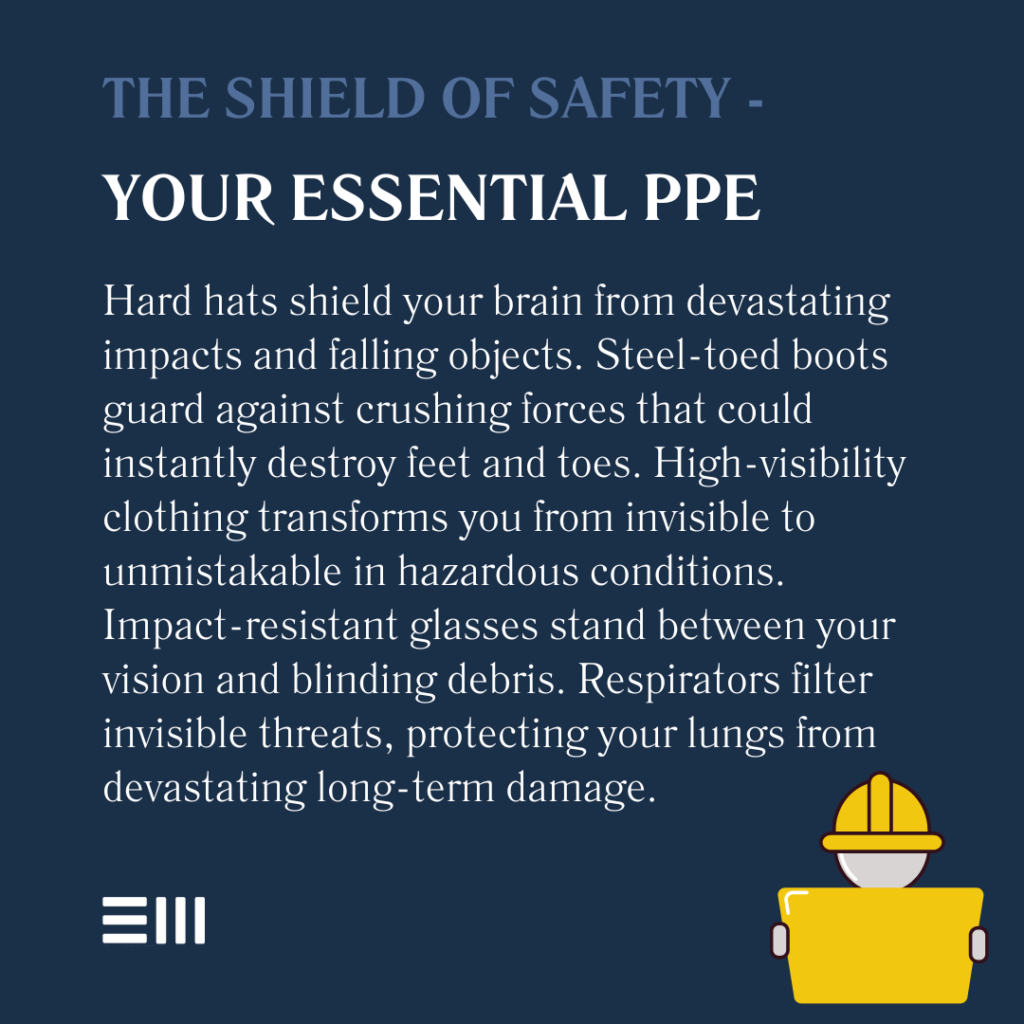
Every 96 minutes, a construction worker loses their life on American job sites. Behind each statistic lies a family forever changed by a preventable workplace tragedy.
These sobering numbers underscore why rigorous safety standards and proper training aren’t just regulatory requirements—they’re matters of life and death.
The top 10 injuries amounted to $48.15 billion in direct workers’ compensation costs in 2020, while the human cost remains immeasurable.
Common Types of Construction Accidents
Construction sites pulse with potential hazards at every turn. Understanding these risks is the first step toward prevention and protection.
Falls from Heights (Responsible for 33.5% of construction fatalities)
- Scaffold collapses;
- Ladder accidents;
- Roofing incidents;
- Unprotected edges;
- Floor openings;
- Elevator shaft work; and
- Bridge construction falls.
Struck-by Incidents (11.1% of construction deaths)
- Vehicle collisions;
- Falling objects;
- Flying debris;
- Equipment strikes;
- Crane accidents;
- Forklift impacts; and
- Swinging loads.
Electrocutions (8.5% of construction fatalities)
- Exposed wiring;
- Power line contact;
- Defective equipment;
- Improper lockout/tagout procedures;
- Wet conditions;
- Underground utilities; and
- Metal ladder contact.
Caught-in/Between Accidents (5.5% of deaths)
- Trench collapses;
- Equipment rollovers;
- Material crushing;
- Machinery entanglement;
- Conveyor belt incidents;
- Storage rack collapses; and
- Vehicle pinning.
Understanding these patterns helps safety managers implement targeted prevention strategies that save lives.

Key OSHA Regulations for Construction Safety
The Occupational Safety and Health Administration establishes comprehensive standards to protect worker safety. Here’s what employers must provide:
Fall Protection Requirements:
- Personal fall arrest systems for work at 6 feet or higher;
- Guardrails around open edges;
- Safety nets where overhead work occurs;
- Regular inspection of fall protection equipment;
- Proper anchor points;
- Fall protection plans; and
- Training documentation.
Equipment Safety Standards:
- Regular machinery maintenance and inspection;
- Proper guarding on all moving parts;
- Clear operational procedures;
- Certified operator training;
- Equipment-specific certifications;
- Maintenance logs; and
- Emergency shutdown protocols.
Personal Protective Equipment (PPE):
- Hard hats meeting ANSI standards;
- Steel-toed boots;
- High-visibility clothing;
- Respiratory protection when needed;
- Eye and face protection;
- Hearing protection in high-noise areas;
- Hand protection appropriate to tasks;
- Fall protection harnesses; and
- Weather-appropriate gear.
These baseline requirements form the foundation of workplace safety compliance. Regular updates and strict enforcement ensure these standards evolve with industry needs and technological advances.

Employer Responsibilities
Construction site safety begins with proper management oversight and commitment to worker protection. Employers hold the primary responsibility for creating and maintaining safe work environments.
Training Requirements:
- Initial safety orientation for all workers;
- Regular refresher courses;
- Hazard-specific training;
- Documentation of all training sessions;
- Bilingual instruction when needed;
- Competent person training;
- Emergency response drills; and
- Equipment-specific certification.
Site Safety Management:
- Daily safety inspections;
- Weekly toolbox talks;
- Monthly safety committee meetings;
- Incident investigation procedures;
- Emergency response plans;
- Hazard communication programs;
- Substance abuse prevention; and
- Weather monitoring protocols.
Record Keeping:
- OSHA 300 logs;
- Safety meeting minutes;
- Equipment inspection records;
- Training certifications;
- Incident reports;
- Near-miss documentation;
- Corrective action tracking; and
- Safety audit results.
These comprehensive responsibilities reflect the employer’s crucial role in protecting worker safety and health. Success requires unwavering commitment from leadership and adequate resource allocation.
Worker Rights and Responsibilities
Every construction worker plays a vital role in maintaining job site safety. Understanding both rights and responsibilities creates a foundation for an effective safety culture.
Worker Rights:
- Safe working conditions;
- Proper safety equipment;
- Safety training in their language;
- Right to report hazards without retaliation;
- Access to workplace injury records;
- OSHA complaint filing ability;
- Medical examination results;
- Exposure monitoring data;
- Safety Data Sheets (SDS); and
- Injury and illness records.
Worker Responsibilities:
- Follow safety procedures;
- Use provided PPE correctly;
- Report hazards immediately;
- Participate in safety training;
- Maintain clean work areas;
- Know emergency procedures;
- Report near-miss incidents;
- Assist in accident investigations;
- Monitor coworker safety; and
- Maintain tool safety.
Meeting these responsibilities helps create a culture of safety that protects everyone on the job site.
Prevention Strategies
Proactive safety measures save lives and protect workers from injury.
Site Organization:
- Clear signage and warnings;
- Designated storage areas;
- Well-marked traffic routes;
- Adequate lighting;
- Regular housekeeping;
- Proper material storage;
- Emergency exit paths;
- Designated smoking areas;
- Waste disposal zones; and
- Equipment staging areas.
Communication Systems:
- Daily safety briefings;
- Hand signals for crane operations;
- Radio protocols;
- Emergency notification systems;
- Language accommodation;
- Safety suggestion programs;
- Near-miss reporting procedures;
- Hazard alert systems;
- Weather warning protocols; and
- Shift handover procedures.
Weather Considerations:
- Heat stress prevention;
- Cold weather protocols;
- Lightning safety procedures;
- Wind restrictions for elevated work;
- Wet weather adaptations;
- Air quality monitoring;
- Snow and ice removal;
- Hurricane preparations;
- Tornado procedures; and
- Flood prevention measures.
These weather-related protocols protect workers from environmental hazards that can change rapidly.
Advanced Safety Technologies
Modern construction sites increasingly rely on technology to enhance safety measures and prevent accidents.
Monitoring Systems:
- Wearable safety devices;
- Proximity warning systems;
- Environmental sensors;
- Fatigue monitoring;
- Gas detection equipment;
- Motion sensors;
- Video surveillance;
- Biometric scanning;
- GPS tracking; and
- Remote shutdown capabilities.
Digital Safety Management:
- Safety app implementations;
- Real-time reporting systems;
- Digital training platforms;
- Automated inspection tools;
- Compliance tracking software;
- Risk assessment programs;
- Incident management systems;
- Safety analytics dashboards;
- Digital documentation; and
- Remote monitoring capabilities.
Digital tools streamline safety management while improving accuracy and accessibility of critical information.
Frequently Asked Questions About Construction Accidents in Alabama
Understanding construction safety regulations helps protect your rights and ensure compliance on the job site. These questions address the most common concerns we hear from workers and employers alike.
What Should I Do Immediately After a Construction Accident?
Seek medical attention first, then report the incident to your supervisor. Document everything you can about the accident, including photos if possible, and gather witness information.
A proper response in the first hour after an accident can significantly impact both recovery and legal outcomes.
How Long Do I Have to Report a Construction Accident?
OSHA requires employers to report fatalities within 8 hours and severe injuries within 24 hours. For workers’ compensation claims, deadlines vary by state but typically range from 30-90 days.
Missing these deadlines can seriously impact your ability to receive compensation.
Can I Refuse Unsafe Work?
Yes, workers have the right to refuse tasks they reasonably believe pose an imminent danger. OSHA protects workers from retaliation for such refusals. Document any unsafe conditions and your communication with supervisors about safety concerns.
Who Pays for Medical Treatment After a Construction Accident?
Workers’ compensation insurance typically covers medical expenses related to workplace injuries. In some cases, third-party claims may provide additional compensation.
Understanding your coverage options ensures you receive proper medical care without financial burden.
What Training Must Employers Provide?
Employers must provide training on specific hazards, proper equipment use, emergency procedures, and workers’ rights.
Training must be in a language workers understand and be documented with regular refresher courses.
Take Action for Your Safety
Don’t wait for an accident to happen before addressing construction safety concerns.
Our experienced team can help you navigate the complex landscape of construction safety regulations and workplace injury claims.
Contact us or visit our office to protect your rights and ensure proper compensation for construction-related injuries. Every moment matters when it comes to workplace safety and injury claims.
Can't find what you're looking for? Search our site below.










